托福分数对照表及托福评分标准解析(汇总)
托福阅读分数换算表及阅读常考题型总结

托福阅读分数换算表及阅读常考题型总结托福小白可能对于托福考试的评分有很多疑问,比如阅读的题量和分数是如何换算的?阅读每篇14道题,一共考3篇,如果遇到加试,可能会考4-5篇阅读,加试题目不计入总分。
跟小编一起来看看托福阅读分数换算表和托福阅读常考的题型托福阅读分数换算表及阅读常考题型总结一.托福阅读分数换算表除重要观点题和归类题以外,每道题的分值都是1分,重要观点题的分值可能是2分,归类题为3或4分,考试所得分数范围:0-30分。
大家在算出原始分数以后,将被转化为0-30分的最终分数。
以下是托福阅读评分标准中原始分数与最终分数的对照表:二.托福阅读常考题型托福阅读题型共分为10种:1. Factual Information questions(事实信息题)2. Negative Factual Information questions(否定事实信息题)3. Inference questions(推论题)4. Rhetorical Purpose questions(修辞目的题)5. Vocabulary questions(词汇题)6. Reference questions(指代题)7. Sentence Simplification questions(句子简化题)8. Insert Text question(句子插入题)9. Prose Summary(文章总结题)10. Fill in a Table(表格填写题)托福阅读TPO30第3篇:The Invention of the Mechanical Clock 【1】In Europe, before the introduction of the mechanical clock, people told time by sun (using, for example, shadow sticks or sun dials) and water clocks. Sun clocks worked, of course, only on clear days; water clocks misbehaved when the temperature fell toward freezing, to say nothing of long-run drift as the result of sedimentation and clogging. Both these devices worked well in sunny climates; but in northern Europe the sun may be hidden by clouds for weeks at a time, while temperatures vary not only seasonally but from day to night.【2】Medieval Europe gave new importance to reliable time. The Catholic Church had its seven daily prayers, one of which was at night, requiring an alarm arrangement to waken monks before dawn. And then the new cities and towns, squeezed by their walls, had to know and order time in order to organize collective activity and ration space. They set a time to go to sleep. All this was compatible with older devices so long as there was only one authoritative timekeeper; but with urban growth and the multiplication of time signals, discrepancy brought discord and strife. Society needed a more dependable instrument of time measurement and found it in the mechanical clock.【3】We do not know who invented this machine, or where.It seems to have appeared in Italy and England (perhaps simultaneous invention) between 1275 and 1300. Once known, it spread rapidly, driving out water clocks but not solar dials, which were needed to check the new machines against the timekeeper of last resort. These early versions were rudimentary, inaccurate, and prone to breakdown.【4】Ironically, the new machine tended to undermine Catholic Church authority. Although church ritual had sustained an interest in timekeeping throughout the centuries of urban collapse that followed the fall of Rome, church time was nature’s time. Day and night were divided into the same number of parts, so that except at the equinoxes, days and night hours were unequal; and then of course the length of these hours varied with the seasons. But the mechanical clock kept equal hours, and this implied a new time reckoning. The Catholic Church resisted, not coming over to the new hours for about a century. From the start, however, the towns and cities took equal hours as their standard, and the public clocks installed in town halls and market squares became the very symbol of a new, secular municipal authority. Every town wanted one; conquerors seized them as especially precious spoils of war; tourists came to see and hear these machines the way they made pilgrimages to sacred relics.【5】The clock was the greatest achievement of medieval mechanical ingenuity. Its general accuracy could be checked against easily observed phenomena, like the rising and setting of the sun. The result was relentless pressure to improve technique and design. At every stage, clockmakers led the way to accuracy and precision; they became masters of miniaturization, detectors and correctors of error, searchers for new and better. They werethus the pioneers of mechanical engineering and served as examples and teachers to other branches of engineering.【6】The clock brought order and control, both collective and personal. Its public display and private possession laid the basis for temporal autonomy: people could now coordinate comings and goings without dictation from above. The clock provided the punctuation marks for group activity, while enabling individuals to order their own work (and that of others) so as to enhance productivity. Indeed, the very notion of productivity is a by-product of the clock: once one can relate performance to uniform time units, work is never the same. One moves from the task-oriented time consciousness of the peasant (working on job after another, as time and light permit) and the time-filling busyness of the domestic servant (who always had something to do) to an effort to maximize product per unit of time.托福阅读TPO30试题第3篇:The Invention of the Mechanical Clock1.Why does the author provide the information that "in northern Europe the sun may be hidden by clouds for weeks at a time, while temperatures vary not only seasonally but from day to night"?A.To emphasize the variety of environments in which people used sun and water clocks to tell time.B.To illustrate the disadvantage of sun and water clocks.C.To provide an example of an area where water clocks have an advantage over sun clocks.D.To counter the claim that sun and water clocks were used all over Europe.2.According to paragraph 2, all of the following are examplesof the importance of timekeeping to medieval European society EXCEPTA.the need of different towns to coordinate timekeeping with each other.B.the setting of specific times for the opening and closing of markets.C.the setting of specific time for the start and finish of the working day.D.the regulation of the performance of daily church rituals.3.According to paragraph 2, why did the medieval church need an alarm arrangement?A.The alarm warned the monks of discord or strife in the town.B.The church was responsible for regulating working hours and market hours.C.The alarm was needed in case fires were not put out each night.D.One of the church's daily rituals occurred during the night.4.The word "authoritative" in the passage(paragraph 2)is closest in meaning toA.actual.B.important.C.official.D.effective.5.The author uses the phrase "the timekeeper of last resort" to refer toA.water clocks.B.the sun.C.mechanical clocks.D.the church.6.The word "rudimentary" in the passage(paragraph 3)is closest in meaning toA.rare.B.small.C.impractical.D.basic.7.According to paragraph 4, how did the Catholic Church react to the introduction of mechanical clocks?A.Its used mechanical clocks through the period of urban collapse.B.It used clocks to better understand natural phenomena, like equinoxes.C.It tried to preserve its own method of keeping time, which was different from mechanical-clock time.D.It used mechanical clocks to challenge secular, town authorities.8.The word "installed" in the passage(paragraph 4)is closest in meaning toA.required.B.expected by the majority of people.C.standardized.D.put in place.9.It can be inferred from paragraph 5 that medieval clockmakersA.were able to continually make improvements in the accuracy of mechanical clocks.B.were sometimes not well respected by other engineers.C.sometimes made claims about the accuracy of mechanical clocks that were not true.D.rarely shared their expertise with other engineers.10.Paragraph 5 answers which of the following questions about mechanical clocks.A.How did early mechanical clocks work?B.Why did the design of mechanical clocks affect engineering in general?C.How were mechanical clocks made?D.What influenced the design of the first mechanical clock?11.The word "pioneers" in the passage isclosest in meaning toA.leaders.B.opponents.C.employers.D.guardians.12.According to paragraph 6, how did the mechanical clock affect labor?A.It encouraged workers to do more time-filling busywork.B.It enabled workers to be more task oriented.C.It pushed workers to work more hours every day.D.It led to a focus on productivity.13. Look at the four squares[■] that indicate where the following sentence can be added to the passage. Where would the sentence best fit? The division of time no longer reflected the organization of religious ritual.Ironically, the new machine tended to undermine Catholic Church authority. Although church ritual had sustained an interest in timekeeping throughout the centuries of urban collapse that followed the fall of Rome,church time was nature's time.■【A】Day and night were divided into the same number of parts, so that except at the equinoxes, days and night hours were unequal;and then of course the length of these hours varied withthe seasons.■【B】But the mechanical clock kept equal hours, and this implied a new time reckoning.■【C】The Catholic Church resisted, not coming over to the new hours for about acentury.■【D】From the start, however, the towns and cities took equal hours as their standard, and the public clocks installed in town halls and market squares became the very symbol of a new, secular municipal authority. Every town wanted one; conquerors seized them as especially precious spoils of war;tourists came to see and hear these machines the way they made pilgrimages to sacred relics.14. Directions: An introductory sentence for a brief summary of the passage is provided below. Complete the summary by selecting the THREE answer choices that express the most important ideas in the passage. Some sentences do not belong in the summary because they express ideas that are not presented in the passage or are minor ideas in the passage. This question is worth 2 points.The introduction of the mechanical clock caused important changes to the society of medieval Europe.A.The increasing complexity of social and economic activity in medieval Europe led to the need for a more dependable means of keeping time than sun and water clocks provided.B.Because they were unreliable even in sunny climates, sun clocks and water clocks were rarely used in Europe, even before the invention of the mechanical clock.C.Before the mechanical clock, every city wanted a large number of timekeepers because more timekeepers allowed for better organization of collective activities.D.Soon after the invention of mechanical clocks, sun and water clocks became obsolete because mechanical clocks werefar more accurate.E.Predators help maintain biological diversity by limiting populations of a dominant competitor species, thereby preventing that species from excluding others.F.The removal of sea stars reduces the diversity of the community in which they are predators, and is therefore a bad idea.托福阅读TPO30答案第3篇:The Invention of the Mechanical Clock1.从第一段的第二句开始,原文列举了这两种device各种的缺点,最后一句前半句说它们work,后面but表转折,证明要说有些情况它们不能用。
托福改革阅读分数对照表
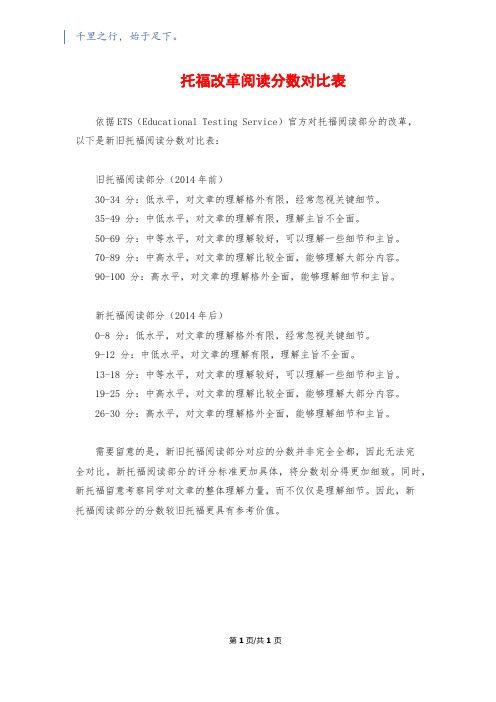
千里之行,始于足下。
托福改革阅读分数对比表
依据ETS(Educational Testing Service)官方对托福阅读部分的改革,
以下是新旧托福阅读分数对比表:
旧托福阅读部分(2014年前)
30-34 分:低水平,对文章的理解格外有限,经常忽视关键细节。
35-49 分:中低水平,对文章的理解有限,理解主旨不全面。
50-69 分:中等水平,对文章的理解较好,可以理解一些细节和主旨。
70-89 分:中高水平,对文章的理解比较全面,能够理解大部分内容。
90-100 分:高水平,对文章的理解格外全面,能够理解细节和主旨。
新托福阅读部分(2014年后)
0-8 分:低水平,对文章的理解格外有限,经常忽视关键细节。
9-12 分:中低水平,对文章的理解有限,理解主旨不全面。
13-18 分:中等水平,对文章的理解较好,可以理解一些细节和主旨。
19-25 分:中高水平,对文章的理解比较全面,能够理解大部分内容。
26-30 分:高水平,对文章的理解格外全面,能够理解细节和主旨。
需要留意的是,新旧托福阅读部分对应的分数并非完全全都,因此无法完
全对比。
新托福阅读部分的评分标准更加具体,将分数划分得更加细致。
同时,新托福留意考察同学对文章的整体理解力量,而不仅仅是理解细节。
因此,新
托福阅读部分的分数较旧托福更具有参考价值。
第1页/共1页。
小托福评分标准与评分对照表解析
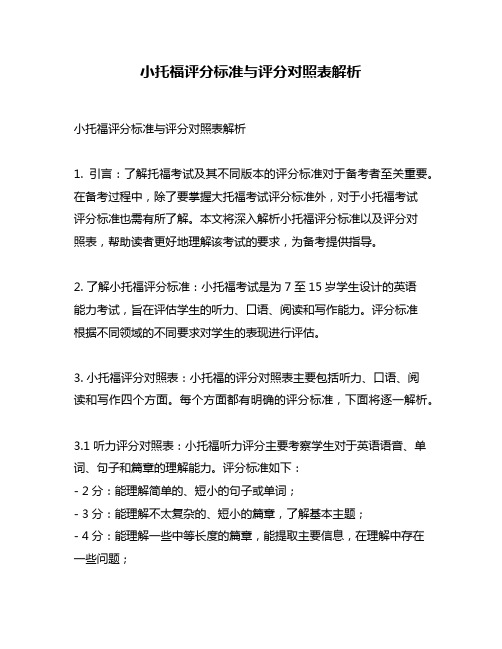
小托福评分标准与评分对照表解析小托福评分标准与评分对照表解析1. 引言:了解托福考试及其不同版本的评分标准对于备考者至关重要。
在备考过程中,除了要掌握大托福考试评分标准外,对于小托福考试评分标准也需有所了解。
本文将深入解析小托福评分标准以及评分对照表,帮助读者更好地理解该考试的要求,为备考提供指导。
2. 了解小托福评分标准:小托福考试是为7至15岁学生设计的英语能力考试,旨在评估学生的听力、口语、阅读和写作能力。
评分标准根据不同领域的不同要求对学生的表现进行评估。
3. 小托福评分对照表:小托福的评分对照表主要包括听力、口语、阅读和写作四个方面。
每个方面都有明确的评分标准,下面将逐一解析。
3.1 听力评分对照表:小托福听力评分主要考察学生对于英语语音、单词、句子和篇章的理解能力。
评分标准如下:- 2分:能理解简单的、短小的句子或单词;- 3分:能理解不太复杂的、短小的篇章,了解基本主题;- 4分:能理解一些中等长度的篇章,能提取主要信息,在理解中存在一些问题;- 5分:能理解长篇章的主要内容,并能提取细节信息;- 6分:能全面理解长篇章主要内容,并能提取并理解其中的细节信息。
3.2 口语评分对照表:小托福口语评分主要考察学生的语音、流利度、词汇、语法和交际能力。
评分标准如下:- 2分:能发出简单的、不太准确的词语和句子;- 3分:能使用一些简单的句子,但表达不够准确流利;- 4分:能使用一些基本的句子,但表达仍然有限;- 5分:能使用中等难度的句子,能表达清晰准确的意思;- 6分:能使用复杂的语句,对语音、语法和词汇使用较为准确。
3.3 阅读评分对照表:小托福阅读评分主要考察学生理解短文、文章和图表的能力。
评分标准如下:- 2分:能理解简单的词汇和句子;- 3分:能理解不太复杂的文章,并能理解基本主题;- 4分:能理解中等难度的文章,并能提取主要信息,在理解中存在一些问题;- 5分:能理解较长篇章的主要内容,并能提取细节信息;- 6分:能全面理解长篇章的主要内容,并能提取并理解其中的细节信息。
托福阅读评分标准:阅读成绩是如何计算的

托福阅读评分标准:阅读成绩是如何计算的许多备考的同学会存在一个疑问,托福阅读部分的成绩是如何来计算的?下面就将为大家解答。
托福阅读评分标准:阅读成绩是如何计算的托福阅读考试的时间是60-80分钟,需要完成3-4篇文章,每篇文章的字数大约有700字左右,每天文章的出题数是12-14题。
当然不同一题型的分值是不一样的。
在了解托福阅读的评分方式之前,我们应该要了解的是托福阅读的题型。
托福阅读题型共分为10种:1. Factual Information questions(事实信息题)2. Negative Factual Information questions(否定事实信息题)3. Inference questions(推论题)4. Rhetorical Purpose questions(修辞目的题)5. Vocabulary questions(词汇题)6. Reference questions(指代题)7. Sentence Simplification questions(句子简化题)8. Insert Text question(句子插入题)9. Prose Summary(文章总结题)10. Fill in a Table(表格填写题)了解了托福阅读的题型,我们再来看一下托福阅读的计分方式:托福阅读以选择题为主,除最后的文章总结题和表格填写题之外,每道题的分值都是1分。
文章总结题满分为2分。
这道题会给出6个选项,要求考生从中选出3个最能概括文章内容的选项。
在评分方面,文章总结题每道题2分。
如果这道题没有选对答案或只选对1个选项,不得分;如果这道题选对2个选项,得1分;如果这道题选对了3个选项,得2分。
表格填写题满分为3分。
这道题会有2或3栏/行表格,包括5个正确答案选项。
考生需要在备选答案中挑出正确选项,并将正确选项拖入表格中的相应位置。
表格填写题满分为3分。
没有答对或只答对1或2个答案不得分;答对3个答案得1分;答对4个答案得2分;5个全对得满分3分。
托福改革阅读分数对照表
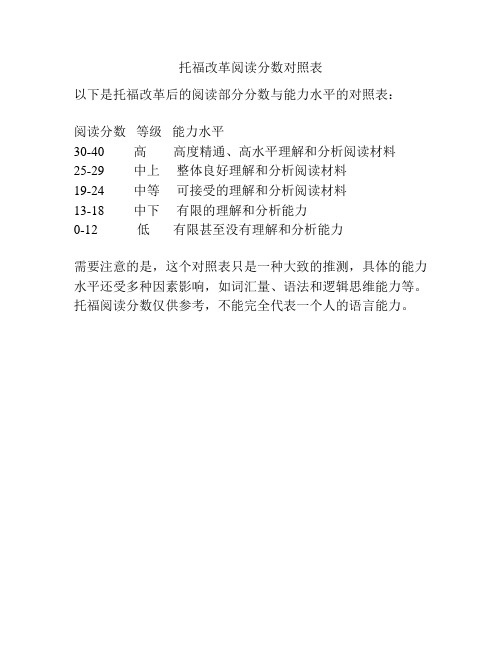
托福改革阅读分数对照表
以下是托福改革后的阅读部分分数与能力水平的对照表:
阅读分数等级能力水平
30-40 高高度精通、高水平理解和分析阅读材料
25-29 中上整体良好理解和分析阅读材料
19-24 中等可接受的理解和分析阅读材料
13-18 中下有限的理解和分析能力
0-12 低有限甚至没有理解和分析能力
需要注意的是,这个对照表只是一种大致的推测,具体的能力水平还受多种因素影响,如词汇量、语法和逻辑思维能力等。
托福阅读分数仅供参考,不能完全代表一个人的语言能力。
新托福评分标准
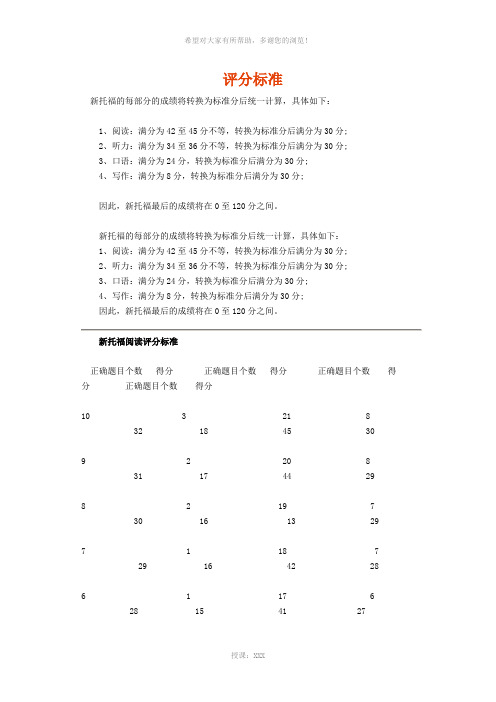
评分标准新托福的每部分的成绩将转换为标准分后统一计算,具体如下:1、阅读:满分为42至45分不等,转换为标准分后满分为30分;2、听力:满分为34至36分不等,转换为标准分后满分为30分;3、口语:满分为24分,转换为标准分后满分为30分;4、写作:满分为8分,转换为标准分后满分为30分;因此,新托福最后的成绩将在0至120分之间。
新托福的每部分的成绩将转换为标准分后统一计算,具体如下:1、阅读:满分为42至45分不等,转换为标准分后满分为30分;2、听力:满分为34至36分不等,转换为标准分后满分为30分;3、口语:满分为24分,转换为标准分后满分为30分;4、写作:满分为8分,转换为标准分后满分为30分;因此,新托福最后的成绩将在0至120分之间。
新托福阅读评分标准正确题目个数得分正确题目个数得分正确题目个数得分正确题目个数得分10 3 21 832 18 45 309 2 20 831 17 44 298 2 19 730 16 13 297 1 18 729 16 42 286 1 17 628 15 41 275 0 16 627 14 40 264 0 15 526 13 39 253 0 14 525 12 38 242 0 13 424 11 37 231 0 12 423 10 36 223 3 19 1132 29 35 213420口语评分标准:新托福口语考试的评分标准与其它外语类考试的口语部分有本质上的区别。
希望考生在看完本文之后能明白考试方向,并根据自己的特点去制定口语复习策略。
我们来详细分析口语考试每个分数段的评分标准:四分评分标准ANSWER TO QUESTIONThe student answers the question thoroughly.COMPREHENSIBILITYThe student can be understood completely.ORGANIZATIONThe student‘s response is well organized and developed.FLUENCYThe student‘s speech is generally fluent. PRONUNCIATIONThe student has generally good pronunciation.GRAMMARThe student uses advanced grammatical structures with a high degree of accuracy.VOCABULARYThe student uses advanced vocabulary with a high degree of accuracy.从上表,我们能够得知,口语分别从六个方面对考生的英文水平进行评估。
toefl junior分数对照表

toefl junior分数对照表
TOEFL Junior 分数对照表
TOEFL Junior是一种测试学生英语能力的专业评估,它包括三部分:听、说和阅读理解。
参加此测试,学生可以收获到一个跨国统一的成绩,用于标识英语学习水平。
TOEFL Junior的分数范围一般由0至120分,下表是TOEFL Junior分数的对照表,供学生参考:
| TOEFL Junior 分数 | 等级 |
| :-------------: | :-------------: |
| 120分 | 高能力 |
| 115 – 119分 | 良好 |
| 100 – 114分| 中等 |
| 70 – 99分 | 尚可满足基本要求 |
| 0 – 69分 | 低于基本要求 |
TOEFL Junior分数可以帮助学生更好地了解自己的英语程度,从而更有针对性地提升英语水平,同时可以用于申请世界名校的准入标准的考查。
对于想要评估英语水平的学生来说,参加TOEFL Junior考试是很不错的选择。
若想要取得较高分数,学生可以通过多方了解、取证书及定期练习的方式提高英语等级。
建议小学生通过完成新闻、故事书分阅读和完成聆听练习来提高听力和表达能力,从而提高TOEFL Junior考试分数。
托福分数对照表及托福评分标准解析(汇总)

托福分数对照表及托福评分标准解析(汇总)托福分数对照表及托福评分标准解析(汇总)本文由三立教育整理,包括托福听力、写作、阅读、口语部分的评分标准和分数对照。
考生可查看你所需要了解的部分,更多托福报名官网、托福考点解析请关注三立教育。
托福口语评分标准以下是关于口语部分的托福评分标准。
分为总原则和更加细分的标准。
总原则:ANSWER TO QUESTIONThe student answers the question thoroughly.COMPREHENSIBILITYThe student can be understood completely.ORGANIZATIONThe student‘s response is well organized and developed.FLUENCYThe student‘s speech is generally fluent.PRONUNCIATIONThe student has generally good pronunciation.GRAMMARThe student uses advanced grammatical structures with a high degree of accuracy. VOCABULARYThe student uses advanced vocabulary with a high degree of accuracy.具体评分细则评分标准:Score:4General Description:The response fulfills the demands of the task, with at most minor lapses in completeness. It is highly intelligible and exhibitssustained, coherent discourse. A response at this level ischaracterized by all of the following.Delivery:Generally well-paced flow (fluid expression). Speech is clear. It may include minor lapses, or minor difficulties with pronunciationor intonation patterns, which do not affect intelligibility. Language Use:The response demonstrates effective use of grammar andvocabulary. It exhibits a fairly high degree of automat city with good controlof basic and complex structures (as appropriate). Some minor (or systemic)errors are noticeable but do not obscure meaning.Topic Development:Response is sustained and sufficient to the task. It is generally well developed and coherent; relationships between ideas are clear(or clear progression of ideas).评分标准:Score:3General Description:The response addresses the task appropriately, but may fall short of being fully developed. It is generally intelligible and coherent,with some fluidity of expression though it exhibits some noticeable lapses in the expression of ideas. A response at this level is characterized by at leasttwo of the following.Delivery:Speech is generally clear, with some fluidity of expression, though minor difficulties with pronunciation, intonation, or pacingare noticeable and may require listener effort at times (though overallintelligibility is not significantly affected).Language Use:The response demonstrates fairly automatic and effective use of grammar and vocabulary andfairly coherent expression ofrelevant ideas. Response may exhibit some imprecise or inaccurate use of vocabulary or grammatical structures used. This may affect overall fluency, but it does not seriously interfere with the communication of the message.Topic Development:Response is mostly coherent and sustained and conveysrelevant ideas information. Overall development is some what limited, usually lacks elaboration or specificity. Relationships between ideas may at times not be immediately clear.评分标准:Score:2General Description:The response addresses the task, but development of the topic is limited. It contain sintelligible speech, although problems with delivery and/or overall coherenceoccur; meaning may be obscured in places. A response at this level is characterized by at least two of the following. Delivery:Speech is basically intelligible, though listener effort is needed because of unclear articulation, awkward intonation, or choppyrhythm pace; meaning may be obscured in places.Language Use:The response demonstrates limited range and control of grammar and vocabulary .These limitations often prevent full expression of ideas. For the most part, only basic sentence structures are used successfully and spoken with fluidity. Structures and vocabulary may express mainly simple(short) and/or general propositions, with simple or unclear connections made among them (serial listing, conjunction, juxtaposition).Topic Development:The response is connected to the task, though thenumber ofideas presented or the development of ideas is limited. Mostly basicideas are expressed with limited elaboration (details and support). At times relevant substance may be vaguely expressed or repetitious. Connections of ideas may be unclear评分标准:Score:1General Description:The response is very limited in content and/orcoherence or is only minimally connected to the task, or speech is largely unintelligible. A response at this level is characterized by at least two of the following.Delivery:Consistent pronunciation, stress, and intonation difficulties cause considerable listener effort; delivery is choppy,fragmented, or telegraphic; frequent pauses and hesitations.Language Use:Range and control of grammar and vocabulary severely limit (or prevent) expression of ideas and connections among ideas. Some low level responses may rely heavily on practiced or formulaic expressions.Topic Development:Limited relevant content expressed. The response generally lacks substance beyond expression of very basic ideas. Speaker may be unable to sustain speech to complete task and may rely heavily on repetition ofthe prompt.评分标准:Score:0Speaker makes no attempt to respond OR response is unrelated to the topic.托福写作评分标准以下是关于写作的托福评分标准。
新托福阅读分数对照表以及答题技巧

新托福阅读分数对照表以及答题技巧新托福阅读相比较老托福阅读增加了词汇量,难度也增加了一些,对于考生们来说正确的复习计划和方法可以让备考变得事半功倍。
首先第一步便是要了解新托福阅读分数换算,学识网今天给大家带来了新托福阅读分数对照表以及一些复习的技巧,一起来看下吧新托福阅读分数对照表以及答题技巧托福阅读总共有3篇文章如遇到加试,则随机3篇文章算分,另1篇文章不算分。
每篇文章700个字,对应14道题目。
其中,13道题是基础信息和推断题,每道题1分。
最后一道题是小结题,俗称大题,满分2分。
大题一般情况下是6选3,3个选项错一个扣一分,扣完为止,即在答题中错2或3个选项,这个题目不得分。
因此,每篇文章对应14个题目,共15分。
为了让大家了解iBT考试的思路和方法,以及题型的设计。
学识网总结出了一些新托福阅读出题的基本思路,和10种基本题型,以及应对10种题型的技巧。
原始分值最终得分原始分值最终得分原始分值最终得分16610要点:an academic environment---越来越偏向于学术的讨论,越来越像IELTS 的Academic类考试reading---a variety of different subjectspassages---3 different categories based on author purpose:1. E某position2. Argumentation3. Historical你需要了解general organization of the passage_classification_comparison/contrast_cause/effect_problem/solution每篇阅读的平均字数是700,当然根据考试的实际情况,可多可少iBT的阅读有10种题型,下面我们一种一种的来回顾:经验:第1、5种题型,占的分量最多,难度也不大,要保证一个也不错第9种和第10种题目,难度最大,想取得高分,必须要多做综合练习剩下的题型也很重要,想取得高分,一个都不能少1. Factual Information Questions这样的题目,一般来说mentioned only in part of the passage. 答题的信息就在段落的1,2句话中。
(完整版)TOEFL评分量表
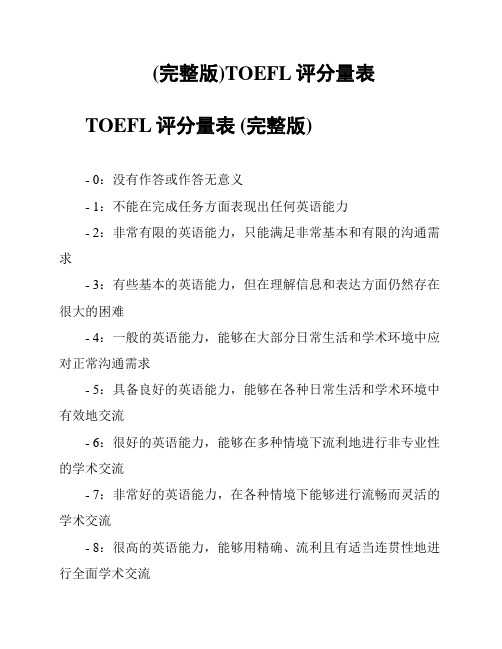
(完整版)TOEFL评分量表TOEFL评分量表 (完整版)
- 0:没有作答或作答无意义
- 1:不能在完成任务方面表现出任何英语能力
- 2:非常有限的英语能力,只能满足非常基本和有限的沟通需求
- 3:有些基本的英语能力,但在理解信息和表达方面仍然存在很大的困难
- 4:一般的英语能力,能够在大部分日常生活和学术环境中应对正常沟通需求
- 5:具备良好的英语能力,能够在各种日常生活和学术环境中有效地交流
- 6:很好的英语能力,能够在多种情境下流利地进行非专业性的学术交流
- 7:非常好的英语能力,在各种情境下能够进行流畅而灵活的学术交流
- 8:很高的英语能力,能够用精确、流利且有适当连贯性地进行全面学术交流
- 9:非常高的英语能力,表达流利、精确、连贯,并具有广泛的词汇和语言资源
以上是根据ETS(Educational Testing Service)对TOEFL考试评分的标准所制定的评分量表。
该评分量表旨在根据考生在听力、阅读、口语和写作四个方面的表现,衡量其英语能力的水平。
采用1-9的九级评分,9分为最高分,0分为最低分。
请注意,以上只是评分的官方参考,具体得分还取决于考试具体的题型和要求。
托福写作评分对应表

托福写作评分对应表
托福写作评分对应表是托福考试中用来评判考生写作水平的标准。
以下是对此表格的描述和解释:
整体分数:托福写作的整体分数范围为0-30分,分为四个等级:0-9分为弱,10-17分为中等,18-25分为强,26-30分为非常强。
任务完成度:任务完成度是评估考生是否能完整地回答所给的问题,是否能充分发挥主题的能力。
任务完成度的分数范围为0-5分,分为五个等级:0分为无法理解,1分为严重不足,2分为不足,3分为基本完成,4-5分为很好完成。
语言使用:语言使用是评估考生使用语言的准确性和多样性的能力。
语言使用的分数范围为0-5分,分为五个等级:0分为无法理解,1分为严重不足,2分为不足,3分为基本完成,4-5分为很好完成。
语法和拼写:语法和拼写是评估考生语法和拼写错误的数量和严重程度的能力。
语法和拼写的分数范围为0-5分,分为五个等级:0分为无法理解,1分为严重不足,2分为不足,3分为基本完成,4-5分为很好完成。
词汇使用:词汇使用是评估考生是否能够使用丰富多样的词汇来表达自己的思想的能力。
词汇使用的分数范围为0-5分,分为五个等级:0分为无法理解,1分为严重不足,2分为不足,3分为基本完成,4-5分为很好完成。
总结:托福写作评分对应表是评估考生写作水平的标准,通过对任务完成度、语言使用、语法和拼写、词汇使用等方面的评估,来给出考生的整体分数。
考生需要注意任务的完成度,语言的准确性和多样性,以及语法和拼写的正确性,同时要尽量使用丰富多样的词汇来表达自己的思想。
小托福评分标准与评分对照表解析
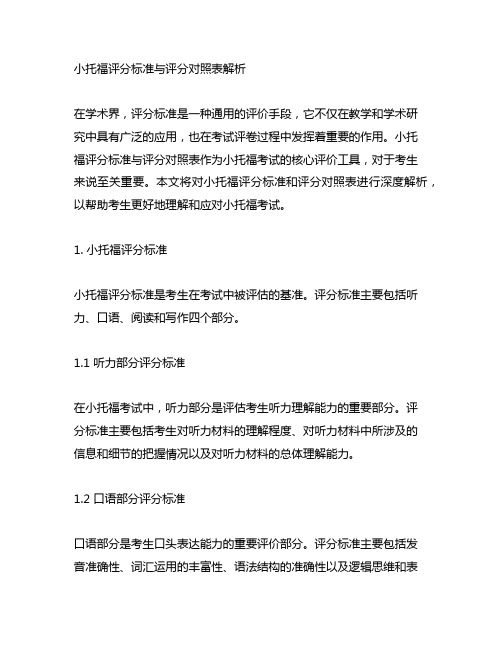
小托福评分标准与评分对照表解析在学术界,评分标准是一种通用的评价手段,它不仅在教学和学术研究中具有广泛的应用,也在考试评卷过程中发挥着重要的作用。
小托福评分标准与评分对照表作为小托福考试的核心评价工具,对于考生来说至关重要。
本文将对小托福评分标准和评分对照表进行深度解析,以帮助考生更好地理解和应对小托福考试。
1. 小托福评分标准小托福评分标准是考生在考试中被评估的基准。
评分标准主要包括听力、口语、阅读和写作四个部分。
1.1 听力部分评分标准在小托福考试中,听力部分是评估考生听力理解能力的重要部分。
评分标准主要包括考生对听力材料的理解程度、对听力材料中所涉及的信息和细节的把握情况以及对听力材料的总体理解能力。
1.2 口语部分评分标准口语部分是考生口头表达能力的重要评价部分。
评分标准主要包括发音准确性、词汇运用的丰富性、语法结构的准确性以及逻辑思维和表达能力。
1.3 阅读部分评分标准阅读部分是考生阅读理解能力的重要考察部分。
评分标准主要包括考生对文章主旨的把握、对文章中细节和信息的理解以及对文章逻辑结构的理解能力。
1.4 写作部分评分标准写作部分是考生表达能力的重要考察部分。
评分标准主要包括写作内容的连贯性、写作语言的丰富性、写作思路的清晰性以及写作逻辑的合理性。
2. 小托福评分对照表解析小托福评分对照表是对考生答题情况进行评分的依据。
评分对照表以具体的评分标准为基准,对考生的答题情况进行定量化评价。
2.1 听力部分评分对照表解析在听力部分的评分对照表中,会根据考生对听力材料的理解程度、对信息和细节的把握情况以及对听力材料的理解能力进行评分。
根据具体的听力表现对应不同的分数,便于对考生答题情况进行客观评价。
2.2 口语部分评分对照表解析口语部分的评分对照表主要以发音准确性、词汇运用的丰富性、语法结构的准确性以及思路表达能力等方面为评分基准,细化的评分对照表能够对考生的口语表现进行详细评价。
2.3 阅读部分评分对照表解析阅读部分的评分对照表主要以考生对文章主旨的把握、对文章中细节和信息的理解以及对文章逻辑结构的理解能力等方面为评分基准,便于对考生的阅读表现进行客观评价。
托福阅读20题评分对照表

托福阅读20题评分对照表
30-34分:表示考生的阅读能力非常弱。
在这个分数范围内,考生可能在阅读理解上遇到较大困难,无法准确把握文章主旨和细节。
35-40分:表示考生的阅读能力较弱。
虽然在这部分分数的考生具有一定的阅读基础,但仍需加强对文章主旨和细节的理解。
41-50分:表示考生的阅读能力一般。
这个分数范围内的考生能够在一定程度上理解和分析文章大意及主要信息,但对某些细节和推理题目可能仍有困惑。
51-60分:表示考生的阅读能力较强。
在这个分数范围的考生能够较好地理解文章内容,包括主旨和细节,并且能够应对推理题目。
61-70分:表示考生的阅读能力很强。
考生在这个分数范围内的阅读理解能力出色,能够全面掌握文章的信息,并对推理题目进行深入的分析。
71-80分:表示考生的阅读能力非常强。
考生在这个分数范围内的阅读能力极为优秀,能够精确理解文章的内容,并在推理题目上作出精准判断。
2023新托福阅读分数对照表

2023新托福阅读分数对照表一、概述新托福考试是国际上非常知名的英语语言能力测试,主要用于申请留学和移民,考试内容包括听力、口语、阅读和写作。
阅读部分是考生展示英语阅读理解能力的重要环节,其成绩对考生的申请结果有着重要的影响。
在2023年,新托福阅读部分的分数对照表做出了一些调整,本文将对这些调整进行详细介绍,并指导考生如何根据阅读分数得知自己的英语水平和申请结果。
二、2023新托福阅读分数对照表在2023年,新托福阅读部分的分数对照表做出了一些调整,主要是对分数段进行重新划分,使得对考生能力的评估更加准确和科学。
具体的分数对照表如下:1. 阅读部分满分为30分,对照表如下:- 30分:考生具备非常出色的阅读理解能力,能够准确理解文中的细节和主旨,并能够进行深入的分析和思考。
- 25-29分:考生的阅读理解能力较强,能够准确把握文章的主旨和中心思想,对细节和推理也有不错的把握能力。
- 20-24分:考生的阅读理解能力一般,能够基本理解文中的主旨和大意,但对于细节和推理方面的理解仍有一定困难。
- 15-19分:考生的阅读理解能力较弱,对文章的理解能力有所欠缺,难以准确把握文章的主旨和细节。
- 10-14分:考生的阅读理解能力明显不足,对文章的理解能力非常薄弱,难以准确把握文章的内容和信息。
- 0-9分:考生的阅读理解能力特殊不足,基本上无法理解文章的内容和信息。
2. 根据阅读分数对照表,考生可以了解自己的英语阅读水平,在申请时对学校和专业进行更加具体的考察和选择。
根据自己的分数段,选择合适的学校和专业,能够提高申请成功的几率。
三、如何提高阅读能力阅读部分是考试中非常重要的一部分,在备考过程中,考生需要通过一定的方法和技巧来提高自己的阅读能力。
以下是一些建议和方法:1. 多读文章:阅读能力的提高需要大量的阅读,考生可以通过阅读英文报纸、杂志、文学作品等不同类型的文章来提高自己的阅读能力。
2. 增强词汇量:扩大词汇量是提高阅读理解能力的重要步骤,考生可以通过背诵单词、阅读词汇书籍等方式来增强自己的词汇量。
托福口语分数对照表详细版
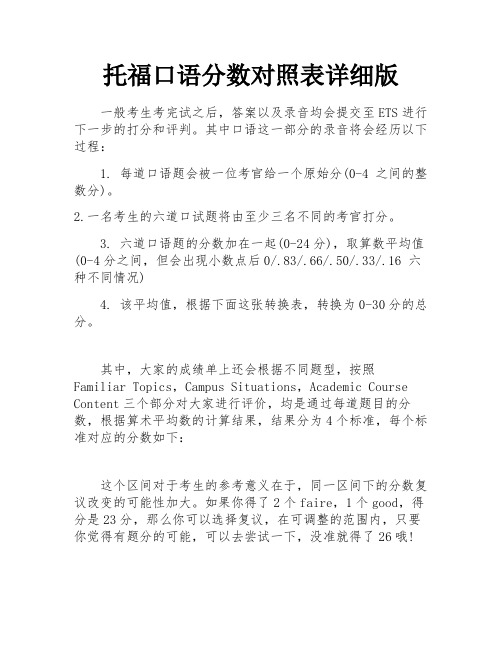
托福口语分数对照表详细版
一般考生考完试之后,答案以及录音均会提交至ETS进行下一步的打分和评判。
其中口语这一部分的录音将会经历以下过程:
1. 每道口语题会被一位考官给一个原始分(0-4 之间的整数分)。
2.一名考生的六道口试题将由至少三名不同的考官打分。
3. 六道口语题的分数加在一起(0-24分),取算数平均值(0-4分之间,但会出现小数点后0/.83/.66/.50/.33/.16 六种不同情况)
4. 该平均值,根据下面这张转换表,转换为0-30分的总分。
其中,大家的成绩单上还会根据不同题型,按照Familiar Topics,Campus Situations,Academic Course Content三个部分对大家进行评价,均是通过每道题目的分数,根据算术平均数的计算结果,结果分为4个标准,每个标准对应的分数如下:
这个区间对于考生的参考意义在于,同一区间下的分数复议改变的可能性加大。
如果你得了2个faire,1个good,得分是23分,那么你可以选择复议,在可调整的范围内,只要你觉得有题分的可能,可以去尝试一下,没准就得了26哦!。
托福考试评分标准
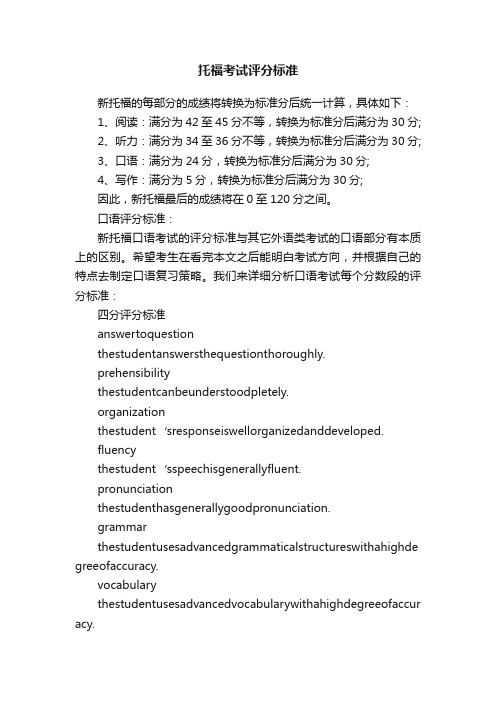
托福考试评分标准新托福的每部分的成绩将转换为标准分后统一计算,具体如下:1、阅读:满分为42至45分不等,转换为标准分后满分为30分;2、听力:满分为34至36分不等,转换为标准分后满分为30分;3、口语:满分为24分,转换为标准分后满分为30分;4、写作:满分为5分,转换为标准分后满分为30分;因此,新托福最后的成绩将在0至120分之间。
口语评分标准:新托福口语考试的评分标准与其它外语类考试的口语部分有本质上的区别。
希望考生在看完本文之后能明白考试方向,并根据自己的特点去制定口语复习策略。
我们来详细分析口语考试每个分数段的评分标准:四分评分标准answertoquestionthestudentanswersthequestionthoroughly.prehensibilitythestudentcanbeunderstoodpletely.organizationthestudent‘sresponseiswellorganizeda nddeveloped.fluencythestudent‘sspeechisgenerallyfluent.pronunciationthestudenthasgenerallygoodpronunciation.grammarthestudentusesadvancedgrammaticalstructureswithahighde greeofaccuracy.vocabularythestudentusesadvancedvocabularywithahighdegreeofaccur acy.从上表,我们能够得知,口语分别从六个方面对考生的英文水平进行评估。
后四个,流利程度、发音、语法及词汇与雅思口语考试评分标准相当。
不同的是,新托福口语考试在语法和词汇的使用上要求更高一些。
而发音和流利程度只要求是generally达到标准就好(generally=formostparts)。
